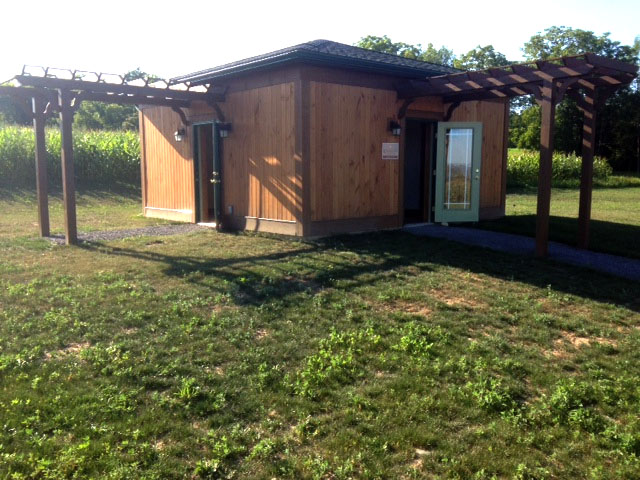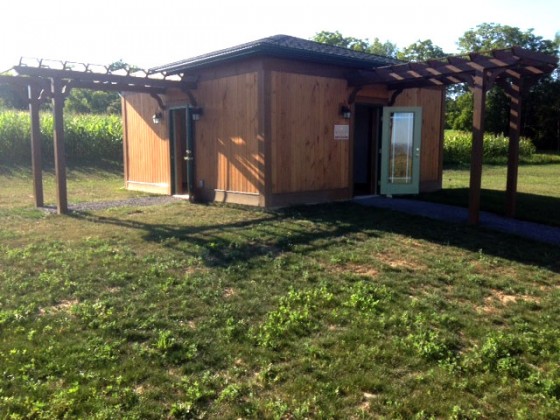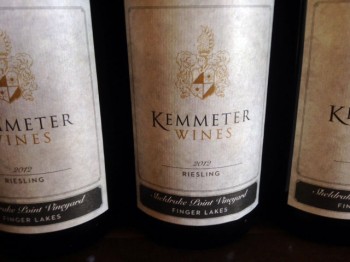The west side of Seneca Lake is home to a regular rush of winery traffic, no small part of which is limos, or buses, or limo buses if you prefer. They can be loud and pleasant, or loud and unpleasant, but there is near-constant motion.
And then there is the newest and the smallest tasting room on Seneca Lake, and it feels like a church. A chapel, rather — a place to reflect and to pause and to think and maybe even to listen.
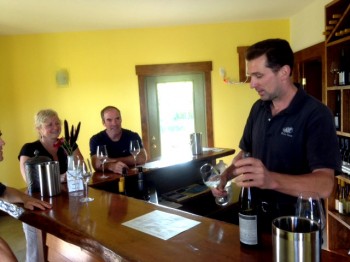
This is, at long last, the home of Kemmeter Wines, and the new home for winemaker Johannes Reinhardt. The German-born winemaker continues to make wine at Anthony Road Wine Company, but now he is free from the burden of uncertainty over a green card. His own business is open. It sits on the hill just across Route 14 from Anthony Road, but the feel is unlike anything else in the Finger Lakes. Visitors — appointment only, and no limos — turn off the main road, and then meander in via a stone road cut through the corn. Next year the road will dissect the first plantings of Kemmeter vines.
The tiny tasting room is a classic work of Mennonite construction, solid and spartan, with the open door allowing fresh air and a clear view of Seneca Lake. You’ll arrive to the sound of Bach, or some alternative piece of classical music. Johannes is smiling — he’s always smiling, yes, but these days he casts a smile befitting a truly liberated man.
“When you have dreamed for so long, and then it becomes real, it’s perhaps easy to feel energized,” he says.
Kemmeter is the maiden name of Johannes’ maternal grandmother. Everything about his wine labels is focused on family, one of the first things visitors learn.
Eventually, Kemmeter will produce their own riesling, gewurztraminer, pinot blanc, pinot noir, and zweigelt. These 20 acres have long rotated crops even though the land looks sculpted specifically for grape growing. Johannes will get no more than 2500 cases, but that’s all he wants, and needs. For now, he’s sourcing his fruit from three vineyards and focusing on riesling.
Sonero
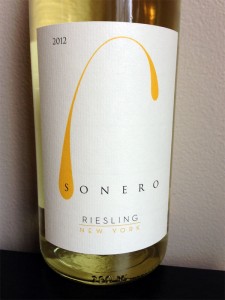 This is the label that Johannes has been sitting on for five years, waiting for the time when he could emblazon it on a bottle of his own wine. The simple design has much more meaning than a visitor might first suspect. In Johannes’ mind, that looping yellow line is the image he sees when his wife Imelda is dancing: tilting her head back and her arm out, an elegant figure alongside his workmanlike steps. The word “Sonero” denotes a Salsa singer with an ability to improvise or freestyle. Johannes and Imelda have become avid fans of the genre.
This is the label that Johannes has been sitting on for five years, waiting for the time when he could emblazon it on a bottle of his own wine. The simple design has much more meaning than a visitor might first suspect. In Johannes’ mind, that looping yellow line is the image he sees when his wife Imelda is dancing: tilting her head back and her arm out, an elegant figure alongside his workmanlike steps. The word “Sonero” denotes a Salsa singer with an ability to improvise or freestyle. Johannes and Imelda have become avid fans of the genre.
When it comes to winemaking, the basic assumption would be that a German would not be much of a freestyler. Johannes confesses his devotion to routine and order. But he has grown to embrace a bit of uncertainty in his winemaking. Most of his rieslings are made with ambient yeast, meaning he allows them to start fermentation without help.
“The juice from one of our three vineyards didn’t start fermenting for eight weeks,” he explains. “Do you know how difficult it is for a German to wait eight weeks? We prefer to set the schedule!”
Sonero is the riesling that Johannes intends to be drunk now, or soon, anyway. It’s approachable, easy going, a bit lower in acidity, and sells for $14.
Three distinct vineyards
The next three rieslings are bottled with a Kemmeter label and the family crest dating back to the 1400s. Johannes knew early on that he wanted to work with fruit from neighboring Red Tail Ridge — “They are setting new standards for quality,” he says — and he wanted fruit from Sheldrake Point on Cayuga Lake. He didn’t have a source on Keuka Lake, and he wanted fruit from a third lake to offer customers a chance to compare the wine’s origins.
In July of 2012 he heard about a vineyard on Lake Ontario called White Pine. Even though it was outside the Finger Lakes, Johannes loved the growers’ passion — and he loved the fruit.
The Red Tail Ridge bottling is laser-beam dry. The other two veer close to semi-dry in profile, but the acidity cuts the sweetness. In all three, there is unexpected texture and length.
“That is one of the most important things to me,” Johannes says. “We have a chance to build wines around this wonderful acidity and add flesh.” He feels the ambient yeast offers the best path toward that end. Each of these three wines sells for $24.
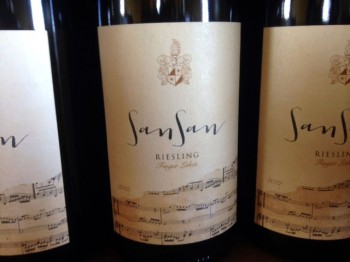 Sansan
Sansan
Johannes is, first and foremost, a dedicated husband. He wanted to honor Imelda on the label of a wine named for her; Sansan is her Chinese name. The result is one of the most elegant labels the region has yet seen, with the bottom third filled out by part of the musical score of Johannes’ favorite piece, the Bach Air Suite Number 3 Air on the G String.
“It’s pretty amazing to be able to offer this wine to our guests,” he says. “For years we didn’t know if this would happen.”
Sansan is made from riesling fruit entirely sourced from Red Tail Ridge. At 5.7% residual sugar, it’s much richer than the other wines, but it’s delicately balanced and made to drink with food. It sells for $30 and has the makings of a wine that will thrive for many years.
Kemmeter’s vines will likely produce their first fruit in 2015, with a much fuller production online in 2016. Johannes initially figured he would focus solely on his own fruit, but he’s enjoying working with fruit from three lakes. “We’ll see,” he says, “but the train has to stay together. If any one jumps off, the whole deal is off. We’d need to keep them all.”
Building a future
After we taste, Johannes signals to the back door. We sneak outside and he points to a spot near the tree line, about 200 feet away. “There it is,” he says, smiling. “That’s where we ducked for cover in that rain storm in 2008. Five years ago, man! That’s where we stood when I told you we would build our own winery. Now we’re here.”
A group of three people is his last appointment on this glistening summer day. The customers taste slowly, asking questions, which Johannes is glad to answer. They weigh down the trunk after nearly 45 minutes with the winemaker. Before they leave, Johannes explains that there is no tasting fee; instead, he and Imelda decided they would leave it up to their guests to decide how much to pay. All of the tasting fee money will go directly to charity. Johannes probably doesn’t want writers to focus on this point, because too much publicity would make it seem like a decision made for publicity’s sake. It’s not. Johannes tells guests they’re not obligated to pay a thing. Many are leaving ten and twenty-dollar bills. Some are leaving more.
I step outside of the tasting room again to take in the view, and I feel the warmth in the air. The music swells from under the bar and spills out the front door. There is a kind of finality to the occasion, but it’s really just another beginning. Not far away, Imelda is preparing dinner. Johannes will close up the tasting room and head home. He has decades to make the wines he envisions. He never wanted to go anywhere else. Finally, he knows he won’t have to.

